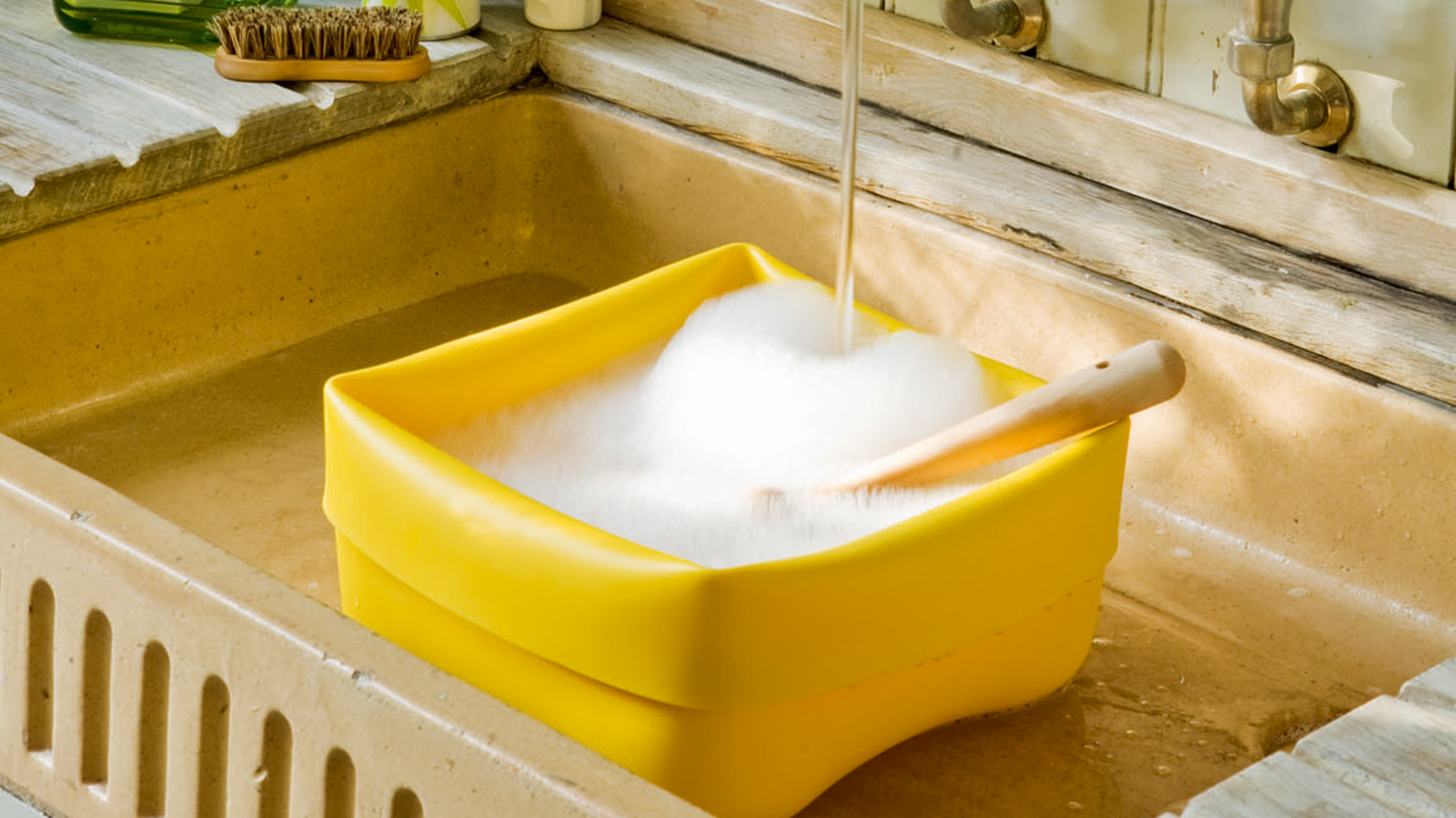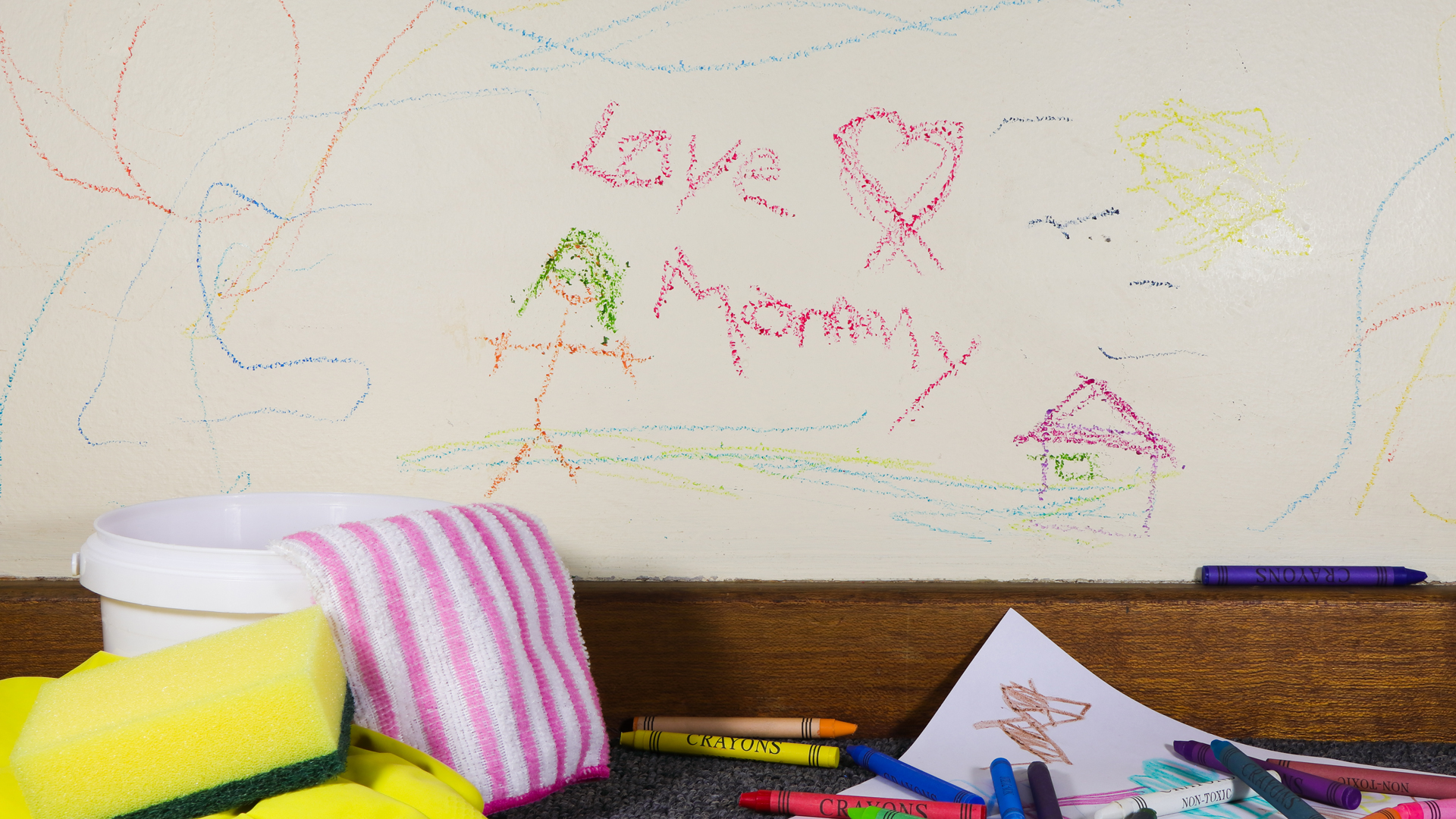How to clean walls to remove marks, stains and scuffs
Wondering how to clean walls without damaging the paint? It's easier than you might think...

Tamara Kelly
Knowing how to clean walls without damaging the paint is a must for busy households to save having to repaint every time a scuff or mark appears – because as careful as you may be, it's almost certainly something that you've had to contend with at some point.
From accidental splashes on kitchen walls, rogue marks in an entrance hall, or children's crayon scribbles... the frustration of seeing your clean paintwork looking less than pristine is a heartbreaking sight, and then there's the dread of trying to clean it, spreading the mess further – similar to that feeling when contemplating how to get stains out of carpets.
Fear not though, as we have asked the experts for the easiest and most effective way to clean walls to remove scuffs and stubborn marks while preserving your best interior paint colors.
How to clean walls without damaging them: 6 simple steps
Thankfully, there are numerous tried-and-tested ways to avoid making walls look worse when cleaning marks off the paintwork. And, if you learn how to clean walls the right way, you won't even have to touch up your best living room paint color to make your space look as good as new!
Here's our simple 6-step guide to cleaning painted walls, without using chemicals
What you'll need:
- Old towels or dust sheets (optional)
- Vacuum cleaner
- Duster
- Liquid soap detergent
- Two sponges or microfibre cloths
1. Consider what type of paint you have on the walls
When considering how to clean walls, there is one thing you always need to consider before getting stuck in: what kind of paint do you have? This will impact the way you treat surface dirt on your walls.
Sign up to our free daily email for the latest royal and entertainment news, interesting opinion, expert advice on styling and beauty trends, and no-nonsense guides to the health and wellness questions you want answered.
Enamel and semi-gloss paints are pretty durable and easy to clean - these are the ones you'll encounter most often when cleaning your kitchen. Flat, satin, and eggshell paints are, however, a little more delicate. "Avoid using a degreaser or any other harsh chemical cleaners on latex-painted walls," warns Paul Baik, Product Manager at Behr Paint Company.
If in doubt, approach cleaning with the most light-handed method, applying the lightest cleaning solution to make sure you don't cause damage.
2. Protect the floors
When thinking about how to clean walls, it also helps to consider other surfaces in the space. If your focus is on the vertical surface in front of you, it's likely not on the rest of the space around you meaning it's easy to spill things on the floor. If you don't want to get chemicals or liquid on your floors during cleaning, use old towels, drop cloths, or even dust sheets to cover the floors right up to the wall.
Not only will these soak up any spillages or liquid splatters, but they will also save you spending any extra time cleaning up when you're done with those walls.
3. Prepare by dusting or vacuuming
As a general rule, whether you're cleaning a leather sofa or cleaning hardwood floors, it's always wise to do some prep work before you get into the proper cleaning. Essentially, you don't want to start washing your walls with liquid only to find you've spread dirt over the surface and cause stains that weren't already there.
Instead, start the process by removing any (near-invisible) dust using a duster or the best vacuum with a long hose. Work from the top of the walls down to encourage excess to fall downwards (rather than resettle on a cleaner section of paintwork). Once you've cleaned off all the excess dirt and dust, you can start getting into the targeted clean.
4. Mix a soapy water cleaning solution

Prepare your washing solution of choice so you're ready to get down to the business of full-wall cleaning. Fill a washing-up bowl or bucket with warm water and add dish soap. "Mix 1 tablespoon of dish soap per 4 cups of water in a bucket or bowl," advises Paul. Fill a second bowl with clean and product-free warm water, to use post soap application to rinse walls.
5. Do a spot test first
Don't jump into cleaning to just get the job done then ruin your whole wall because you neglected to try out your cleaning solution first.
Before you get stuck in, it's important to try cleaning just a small spot on the wall, or a corner of a larger mark, to make sure that whatever product you're using to clean is going to lift the marks, rather than spread the spot.
6. Wash walls with gentle scrubbing
Once you're happy with the results of the patch test then take a soft, non-abrasive sponge or clean microfiber cloth and dip it in the soapy water, ready to start cleaning more thoroughly. "Using one of the soft sponges, wipe down the wall and work the soap into the dirt," suggests Paul. Run it lightly down your wall, starting from the top, stopping to gently scrub stains or marks.
After you've done that, wet the second sponge with clean water from the second (soap-free) bucket, and run it down the same path to clean away any soap or remaining dirt.
"Avoid over-wetting the walls when cleaning, make sure to rinse afterward and allow it to dry completely," adds Erika.
How do you clean dirty walls?
If your walls are in need of a more thorough clean use baking soda for stubborn marks and dirt. Baking soda has been proven to help with all kinds of cleaning tasks, and walls are no exception. First, try applying baking soda and water using a damp cloth. Apply the paste to the stained or marked surface of the walls. Let it sit for ten minutes or so before wiping it off.
If that doesn't do the trick try mixing the baking soda with ammonia, water, and white vinegar, to make a more concentrated cleaning solution, and apply the mixture to the stained or marked surface of the walls following the same time guidelines of ten minutes.
"For tougher stains, a vinegar solution can be a great option," explains Ivan Ivanov, cleaning expert at End of Tenancy Cleaning. "Simply mix a small amount of white vinegar into a large bucket of water. Once you set to work on the stain, circular motions are best to lift any dirt. A microfiber cloth is also a great tool to use as the fibers pick up more dirt than standard cloths while also providing a gentle touch.”
Cleaning with vinegar and baking soda is a great natural solution to many cleaning debacles - whether you're wondering how to clean your oven, how to clean a stainless steel sink, or how to clean copper.

How to clean crayon off walls
The white vinegar option is also useful for removing crayon stains off walls without damaging the paint. Just dip a toothbrush or sponge into neat vinegar and move it lightly over the spot in a slow, circular motion.
Once the crayon stain has been lifted gently wipe the area with a clean microfibre cloth dipped in fresh warm water to remove any traces of vinegar, followed by gently blotting the area with a second clean microfibre cloth to ensure all excess moisture is dried.
Alternative methods to try to clean your walls
Sometimes, all the typical cleaning methods just don't solve the problem. If this is the case for you, here are a few more cleaning solutions you can try.
- A mop head: "Surprisingly, a mop can make for a great tool for cleaning walls," suggests Ivan. "This is an ideal option if you have stains with a large surface, area as the mop head will allow you to clean quickly. Mop heads are gentle enough not to remove paint or wallpaper but can still effectively clean. Just make sure to regularly change the mop water if it gets dirty, and always use a clean, ideally new, mop head."
- Pencil eraser: If the mark on the paint surface is something light and easy to remove, you might be able to remove it without deep cleaning. Some simple tools can come in handy – for instance, a pencil eraser might not be the first thing that comes to mind when considering how to clean walls, but it can work in certain cases! Do note though that you'll want to be particularly careful with matte paint finishes as erasers could leave shiny spots where you rub away at the surface.
- Sticky remover This specialist product is obviously a great choice if you have a sticky residue on your wall (from stickers, for example). Even if it's a scuff mark or other stain, this remover might still work.
- Hair dryer If you don't have sticky remover, you may want to try a hair dryer to remove adhesives. The heat can help loosen the sticky chemicals and make it easier for you to scrape off the residue.
- Surface cleaner If your walls seem to be holding up well to attempt to clean them, but the stain isn't lifting, try a gentle surface cleaner to take off the dirt.
Try these steps and tricks any time you need to clean a mark off your wall. If you're careful to spot test first and work gently, you can avoid causing further damage.
You can also avoid more difficult wall-cleaning procedures by making sure you keep your walls clean all the time. Bacteria can grow quickly on your walls, especially in the bathroom and kitchen. Try washing them every month, maybe even once a fortnight. Regular dusting and vacuuming also won't go amiss.
When the hard work is done and your wall is looking beautiful again, sit back, relax and enjoy your freshly cleaned home. No paint job needed!
Writer and editor Alanna Freeman is an inquisitive storyteller, whose interests—like her beloved global travels—know few boundaries. As well as Woman & Home, she has worked for the likes of Soho House, Telegraph Luxury, Conde Nast Traveller, delicious., Elle, and Vogue, and GQ Australia.
Alanna has been known to turn her hand to copy projects involving souped-up streetcars and cutting-edge technology—she swears they are genuinely both fascinating, even to the uninitiated! A writer who likes to add a bit of color and texture to her work, she has an MA in Communication Design: Illustration from Kingston University.
- Tamara KellyLifestyle Editor